Early Childhood Education and Care is a heavily regulated sector. There are many operating requirements under the governance of the sector including roles and responsibilities.
The National Quality Framework is a national set of standards and frameworks to guide early childhood practice in Australia.
Quality Ratings |
|
|---|---|
|
EXCELLENT |
Service promotes exceptional education and care, demonstrates sector leadership, and is committed to continually improving. |
|
EXCEEDING |
Service goes beyond the requirements of the National Quality Standard in at least four of the seven quality areas. |
| MEETING (National Quality Standard) |
Service meets the National Quality Standard. Service provides quality education and care in all seven quality areas. |
| WORKING TOWARDS (National Quality Standard) |
Service provides a safe education and care program, but there are one or more areas identified for improvement. |
| SIGNIFICANT IMPROVEMENT REQUIRED | There is an identified significant risk to the safety, health and well-being of children. Immediate action will be taken to address issues. |

This topic will explore the early childhood regulatory framework, the National Quality Framework (NQF), and the interrelationships between the components of the Framework.
As we move through this module, you will require the following understanding of the language used in the National Quality Framework:
ELEMENT OF THE NATIONAL QUALITY FRAMEWORK |
ACRONYM OR SHORTENED NAME |
|---|---|
| National Quality Framework | NQF |
| National Quality Standard | NQS |
| Quality Improvement Plan | QIP |
| Learning Framework | Framework |
| Assessment & Rating Process | A&R |
| Early Childhood Education & Care Sector | ECEC |
| Family Day Care | FDC |
| Outside School Hours Care | OSHC |
| Vacation Care | VAC Care |
| Long Day Care / Centre Based Care & Education | LDC |
| Australian Children’s Education & Care Quality Authority | ACECQA |
The National Quality Framework (NQF) is the overarching banner that guides the ECEC sector. The following diagram displays several components within the National Quality Framework:
The Objectives of the NQF:
- ensure the safety, health and well-being of children attending education and care services
- improvement the educational and developmental outcomes for children attending education and care services
- promote continuous improvement in the provision of quality education and care services
- establish a system of national integration and shared responsibility between participating jurisdictions and the Commonwealth in the administration of the National Quality Framework
- improvement public knowledge, and access to information, about the quality of education and care services
- reduce the regulatory and administrative burden for education and care services by enabling information to be shared between participating jurisdiction annd the Commonwealth
The Guiding Principles of the NQF
The rights and the best interest of the children are paramount
The NQF aligns with the United Nations Convention of the Rights of the Child. This treaty ensures that children have the right to be heard, to be free from violence, abuse and neglect, to have the opportunity to thrive, to be engaged in civics and citizenship and opportunities to take action and be accountable. A rights-based approach to delivering education and care means understanding these rights and implementing practice which reflects them.
Children are successful, competent and capable learners
The NQF views children as capable learners who actively construct their own understandings and contribute to others’ learning. It recognises children’s agency, capacity to initiate and lead learning, and their rights to participate in decisions that affect them, including their learning. Viewing children as active participants and decision makers opens up possibilities for educators to move beyond pre-conceived expectations about what children can achieve. This requires educators to respect and work with each child’s unique qualities and abilities.
Equity, Inclusion and Diversity underpin the framework
The NQF recognises all children’s capacity and right to succeed regardless of diverse circumstances, cultural background and abilities. Inclusion is acknowledged as an approach where diversity is celebrated. It requires educators to hold high expectations for the learning and development of all children, recognising that every child treads an individual learning path and will progress in different and equally meaningful ways. In recognising each child’s experience of learning and development, educators implement responsive, equitable, individualised opportunities and additional support if barriers to success are identified.
Australia’s Aboriginal and Torres Straight Islander cultures are valued
The NQF is underpinned by a commitment to ‘Closing the Gap’ and acknowledges Australia is a nation of great diversity, and an ancient land that has been cared for by Indigenous Australians for many thousands of years. Education and care services have a shared responsibility to contribute to building a better society and sustainable environment and to support children, families, colleagues and the local community to understand, respect and value diversity. Through all aspects of their practice, educators challenge stereotyping and bias. They find sensitive and respectful ways to negotiate tensions that may arise, for instance, because of differing values, beliefs and expectations within the local context of the service, and between the local context and the broader contexts of Australian society. Educators take every opportunity to extend children’s understanding of their local context and of their wider world.
The role of families and parents are respected and supported
The NQF acknowledges a view of children in the context of their family and community, that families are children’s first and most influential teachers. It is envisaged that education and care services will actively seek out partnerships and develop secure respectful relationships to ensure that families are informed, consulted and supported in regards to their child’s learning and development.
Best Practice is expected in the provision of education and care services
Inherent within the NQF is a commitment to continuous improvement and striving for best practice underpins this commitment. While the NQF does not prescribe what best practice looks like, it encourages education and care services to draw on a range of current research, theory and understandings about early and middle childhood. This can provide educators with an understanding of best and most suitable practice in the unique and changing context of their service.
ACECQA
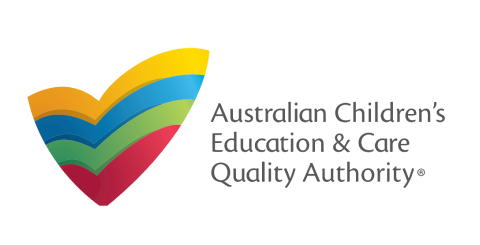
The Australian Children’s Education and Care Quality Authority (ACECQA) is the governing body that works closely with State and Territory governments to ensure services adhere to the National Quality Framework.
Service types governed by the National Quality Framework
The National Quality Framework relates to the following education and care service types:
Long day care
- Often offer care and education to children from 6 weeks through to 6 years
- Often has several classrooms divided into age ranges
- May also combine the provision of OSHC
- Can be privately owned and operated, community-based or part of a large organisation
This 8-minute video presents a long day care service that includes a preschool room. This KU service has been awarded with the highest Excellent rating in 2018. (Note: KU is a not-for-profit sector leading organisation that has been operating since 1895 with services across NSW, ACT, VIC and QLD.)
Outside school hours care
- Can be located on the premises of a school
- Can be located on the premises of a LDC facility
- Often include vacation care for children during school holidays
- Offers education and care to children of school age
- Cession can be before school care, after school care and vacation care
This almost 4-minute video presents an outside school hours care (OSHC) service run by the Catholic Care in Broken Bay diocese. The service offers before and after school care, as well as vacation care
Preschools/kindergartens
- The Australian Government funds state and territory governments to provide quality preschool programs through the Universal Access National Partnership (UANP)1.
- States and territories are responsible for the provision of preschool or kindergarten in their jurisdiction.
- Preschool usually involves being taught by a qualified early childhood teacher (ECT) in a dedicated preschool, although preschool programs are sometimes offered in long day-care centres and other types of child care. In some states, such as ACT, SA, NSW, NT, these services are called ‘preschool’, and in other states, such as QLD, TAS, VIC, WA, they are called ‘kindergarten’ or ‘kindy’.
- In Australia, every child is entitled to free or subsidised preschool for 15 hours a week (or 600 hours in a year).
- Preschool programs usually have stronger focus on language, literacy and numeracy skills, creative arts, science and technology, relationships and social competence. Preschool programs usually include ‘transition to school’ programs that aim to help children to become familiar with what happens at ‘big school’ and equip them with the skills they need to succeed in the ‘big school’ environment.
Depending on the service, often offer sessional care for example from 9:00-12:00 or full days, from 9:00-3:00
- Can be located on the premises of a LDC facility
- Children may also attend LDC on the same day depending on time frames of sessions
- If not part of a long day care service, it can be operating as a standalone preschool/kindergarten
- Can be privately or community-owned and operated
- In some instances, it can be located on the premises of a school Offers education and care to children aged 3 to 5 (sometimes up to age 6). Note: By law, all children must be in compulsory schooling by their 6th birthday.
Raisingchildren.net.au, a Government-funded, non-commercial webpage collected preschools-related information across information.
This 1-minute video gives a quick insight in the life of a kindergarten in Victoria, explaining the importance of a kindergarten program.
Family day care
- Usually, part of a Family Day Care scheme that is responsible for a group of Family Day Care educators who operate from their own homes Family Day Care have amendments in the regulations and standards to support their application of the NQF
- Family Day Care educators typically work alone with smaller groups of children
This 9-minute video published by the Queensland Department of Education explains how family day care services operate to align to the National Quality Standards:
This video was created by StartingBlocks.gov.au (founded by ACECQA) and aims to help families choose the right service type for their children:
This 1.25-video will explain how quality early learning helps children’s development.
National Quality Framework Governance
State/territory based regulatory authorities
Regulatory authorities have day-to-day contact with education and care providers and services and:
- grant all approvals, including provider and service approvals
- asses and quality rate services against the NQS and the National Regulations
- monitor and enforce compliance with the National Law and Regulations, including receive and investigate serious incidents and complaints
- work with ACECQA to promote continuous quality improvement and educate the sector and community about the NQF
Each state and territory have a regulatory body (also known as: Regulatory Authorities) responsible for administering the National Quality Framework and monitoring service quality. Their role includes:
- Granting approvals, including provider approval and service approvals
- Assessing and rating services against the National Quality Standard
- Managing investigations into breaches or incidents/serious notifications
- Handling complaints that may lead to further investigations
- Funding and working with services and agencies that support quality, such as:
- the Australian Children’s Education and Care Quality Authority (ACECQA), the national authority that:
- supports state regulatory authorities in administering the NQF
- promotes continuous improvement and national consistency in service quality
- the National Outside School Hours Services Alliance (NOSHSA) that is a network of all Australian State and Territory Out of School Hours Services (OSHC) Associations to promote provision of OSHC Services and act as a united voice to advocate both to Government and the community for excellence in service provision.
- Family Day Care Australia, the national peak body for family day care that supports, represents and promotes the sector in delivering quality outcomes for children.
- Inclusion support services
- the Australian Children’s Education and Care Quality Authority (ACECQA), the national authority that:
- Providing advice to services where necessary.2
Note
The way Regulatory Authorities work vary from state and/or territory, including their processes and their services. You need to be familiar with your state/territory’s Regulatory Authority’s requirements to ensure compliance.
On ACECQA’s website you can read more about RAs’ role and responsibilities, including their contact details for all state/territory.
Authorised Officers are employed by state and territory regulatory authorities. The roles and responsibilities of an authorised officer are set out in the Education and Care Services National Law and may include:
- monitoring education and care services and enforcing compliance
- assessing applications for approval
- conducting assessment and rating visits
- investigating incidents and complaints
- providing advice and guidance.3
While referred to in the law as 'authorised officers', job titles can vary across states and territories depending on their role and the regulatory authority. This table details some of the most common terms used in the states and territories to describe authorised officers.
| ACT | Authorised Officers with some team members referred to as Senior Investigators |
|---|---|
| NSW | Authorised Officers are known as Senior Field Officers, Field Officers and Field Support Officers. They conduct assessment and rating visits, as well as undertaking compliance tasks across the jurisdiction. There is also a Compliance and Investigation team that investigate complex or serious incidents and/or high levels of non-compliance. |
| NT | Compliance Officers and Assessors |
| QLD | Authorised officers. In regional offices, they may also be referred to as an Early Childhood Manager or Early Childhood Officer. |
| SA | Authorised Officers and Senior Authorised Officers |
| TAS | Most staff are Authorised Officers. Roles include Education and Care Assessors, Regulatory Officers and Managers |
| VIC | Authorised officers |
| WA | Assessment Officers or Investigation Officers |
When a service receives a spot check or assessment visit, the Authorised Officer will be from their state or territory Regulatory Authority and must show identification upon entry into the service.
Authorised Officers may ask to observe practice, review documentation or discuss complaints or incidents with managers or staff.
Because it is the responsibility of the Regulatory Authority to investigate incidents and complaints, there may be ongoing engagement with the service to determine an outcome to an investigation.
Please see the video below with ACECQA explaining the Assessment and Rating Process.
Note: An Authorised Officer has a legal right to enter into a service at any time.
Case Study

On Tuesday morning at 8:00 a.m., the doorbell of the service rang and Sharon the Educational Leader and Lead Educator of the nursery went to answer the door. There was a lady standing there with a lanyard around her neck. She shows her ID and introduces herself as the Authorised Officer performing a follow-up visit from an incident last week.
Sharon knows that the service owners and Director are yet to start and will not arrive until 9:00 a.m. Sharon explains that the leadership team are not in the service and asks if she can reschedule, however the Authorised Officer says that she is going to continue the visit.
Sharon asks her to sign in and shows her that she is the current responsible person. She asks what the Authorised Officer would like to see and then shows her around the centre. Sharon takes the Authorised Officer to the Toddler room and introduces her to the team, explaining that she will be observing for a while.
Sharon calls the Director to inform her the Authorised Officer is in the service.
The Authorised Officer observes practice in the Toddler room for 20 minutes and then speaks with the managers when they arrive.
Associated guidelines – What guides our practice?
There are many associated guidelines and documents that support services to adhere to the National Quality Framework. When making decisions about practices, including developing policies, a service must ensure that they follow recognised health authority recommendations and adhere to other guidelines and standards within the sector.

The National Quality Standard includes seven (7) Quality Areas to support services to embed quality practices into their service to enhance outcomes for children.
Each Quality Area has an associated colour to support visual engagement with the Standard.
Within each Quality Area are Standards and Elements that dive deeper into educators, operators, and the service requirements.
| Quality Area 1 |
Educational program and practice Educational program and practice of educators are child-centred, stimulating and maximise opportunities for enhancing and extending each child’s learning and development. |
|---|---|
| Quality Area 2 |
Children’s health and safety Children have the right to experience quality education and care in an environment that safeguards and promotes their health, safety and wellbeing. |
| Quality Area 3 |
Physical environment Physical environment is safe, suitable and provides a rich and diverse range of experiences that promote children’s learning and development. |
| Quality Area 4 |
Staffing arrangements Qualified and experienced educators, who develop warm, respectful relationships with children, create predictable environments and encourage children’s active engagement in the learning program. |
| Quality Area 5 |
Relationships with children Relationships with children are responsive, respectful and promote children’s sense of security and belonging. |
| Quality Area 6 |
Collaborative partnerships with families & communities Collaborative relationships with families are fundamental to achieving quality outcomes for children, and community partnerships based on active communication, consultation and collaboration are essential. |
| Quality Area 7 |
Governance and leadership Effective leadership and governance of the service contributes to quality environments for children’s learning and development. Effective leaders establish shared values for the service and set clear direction for the service’s continuous improvement. |
There are 15 standards in the NQS. There are 30 elements within the NQS.
Here's a copy of the poster created by ACECQA which shows The Components of the National Quality Standards.
Read the article titled "National Quality Standard" by ACECQA for more information on the NQS.

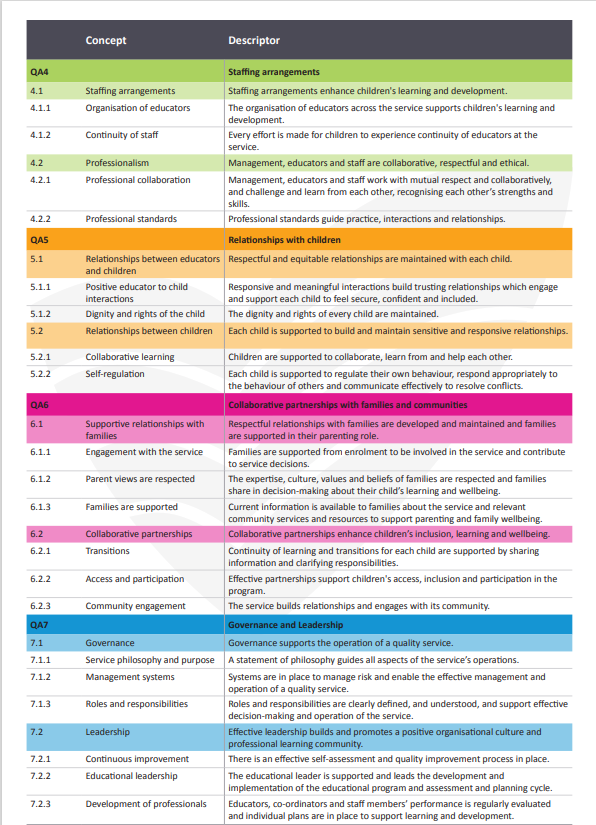
Download your own copy of the National Quality Standards for you to reference when needed. National Quality Standard document.

As depicted at the beginning of the module, some laws and regulations mandate practices to ensure the quality of services. Where laws or regulations are in breach, a service must rectify the issue as soon as possible, or they might be subject to litigation including modifications to their service approval or monetary fines. As with any law or regulation, there are systems in place to monitor adherence to the requirements.
The applied law system was designed to ensure that children had the best opportunity for education and care, and to ensure that service quality was consistent.
When the National Quality Framework was introduced, some states and territories opted to create their own law or regulations and ACECQA recognises those as the appropriate Law and Regulation in that jurisdiction.
Laws & regulations across Australia
A copy of the National Law and State Regulations it can also be found on the ACECQA site.
The following are the current laws and regulations in Australia:
Engaging with the documents
As with any Legislation or Regulation, the terminology is written in legal jargon and format and can be challenging to navigate. One way to engage with the documents is to have a purpose when engaging with them, for example, looking for a particular topic or guideline.
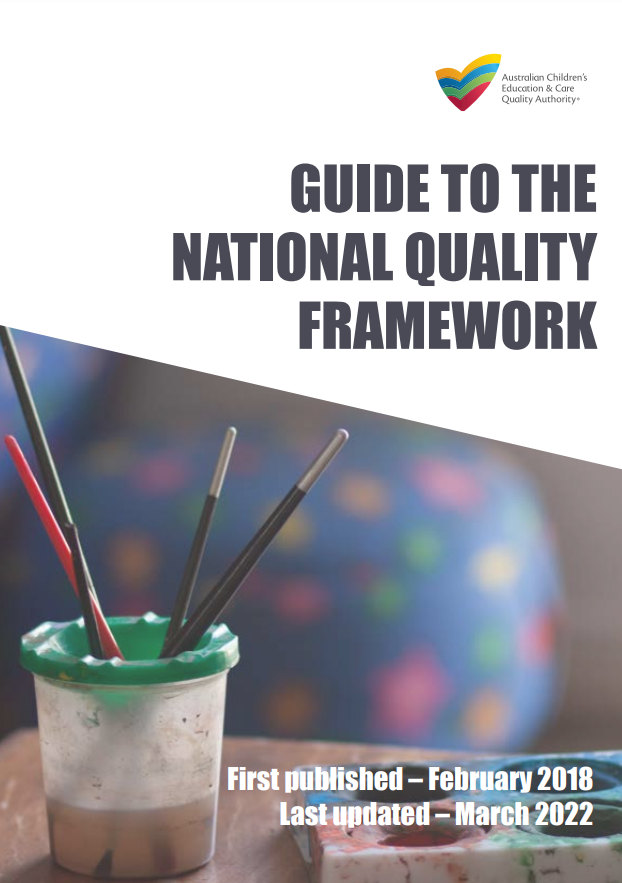
A great way to engage with the law and regulations is to refer to the ‘Guide to the NQF’. This document collates all components of the National Quality Framework including the National Standards, law and regulations. Once you find what you are looking for in the Guide to the NQF, you can explore the law and regulations more effectively.
When reading the documents, you will find that the Law is quite broad, the regulations are more specific, and the standards are even more detailed about how to apply this practice in an ECEC setting.
Note
When engaging with the legal documents, bring them up on your computer then press (control) Ctrl + F (find). A ‘find’ box will present itself and you can type a word or a phrase into the find box and then it will bring up any instances of that word being used in the document.
WA is the only state with a different legislation. All other states have their application Act that can be accessed on the ACECQA website or on the Regulatory Authority websites.
Roles and responsibilities within the framework
Within the Framework, there are key roles that organisations operating ECEC services must have to meet the requirements of the associated legislation. The roles required under the NQF include:
The Approved Provider
Responsible for the operations of the service and ensuring that all laws, regulations and standards are being met.
The Approved Provider is responsible for the financial interactions with the Australian Government along with the families. The Approved Provider is responsible for appointing or undertaking the following key roles:
Nominated Supervisor
Often this person or people are known as the Director or Centre Manager of the service. They are responsible for operating the service on the premises. This person is responsible for all laws, regulations and standards and for managing the service. For example, they are responsible for rosters and ensuring child ratios are maintained, hiring team members, engaging with families, creating a QIP and ensuring the safety and education of children.
The Nominated Supervisor is responsible for ensuring that, at all times, there is a person responsible for day-to-day charge of the service (where they are not available). For example, they would appoint responsible staff in the service who are qualified to make decisions, act in an emergency, and ensure compliance with Laws, Regulations and Standards.
The Nominated Supervisor must ensure that there is an accessibility of information for all staff/Educators on the premises. This includes information about changes for the day, sickness of any staff or children and any event that is occurring that day. Different environments and services will do this in a way which suits their own services. The Nominated Supervisor also holds the same responsibility towards families and parents. Any information that is about their child/children and changes to the daily routine must be communicated and shared effectively and regularly.
The Nominated Supervisor must share information about critical incidents with the department on the day they occur.
acecqa.gov.au/resources/applications/reporting
Visit the NSW Legislation website to review Regulation 11A- Placing a person in day-to-day charge.
Person in day-to-day charge
The approved provider must ensure that a responsible person is present at a centre-based service all times that the service is educating and caring for children. A responsible person is:
- the approved provider or a person with management or control
- a nominated supervisor
- a person in day-to-day charge of the service.
In a family day care service, the responsible person must be available to provide support to family day care educators. This includes being available to be contacted by telephone to provide advice and assistance to a family day care educator. The approved provider may nominate a person to be a nominated supervisor if they meet certain requirements.
A person must be at least 18 years of age to be placed in day-to-day charge of a service. Before placing a person in day-to-day charge, the approved provider or a nominated supervisor must take reasonable steps to ensure that the person:
- has adequate knowledge and understanding of the provision of education and care to children
- has the ability to effectively supervise and manage an education and care service
The approved provider or the nominated supervisor must have regard to:
- has a satisfactory history of compliance with—
- the National Law
- a former education and care services law
- a children’s services law - an education law
- any decision under the National Law, or any other children’s services or education law, to refuse, refuse to renew, suspend, or cancel a licence, approval, registration, certification or other authorisation granted to the person.
Educational Leader
The role of the educational leader is primarily to:
- collaborate with educators and provide curriculum direction and guidance
- support educators to effectively implement the cycle of planning to enhance programs and practices
- lead the development and implementation of an effective educational program in the service
- ensure that children’s learning and development are guided by the learning outcomes of the Early Years Learning Framework and/or the Framework for School Age Care or other approved learning frameworks.
The educational leader of a service plays a significant role in guiding and developing educators’ and families’ understandings about play and leisure-based learning, and the significance of the early years in the education continuum for children. Their approach to leadership for learning has the potential to build the knowledge, skills and professionalism of educators, and to help communicate these important messages to families, schools and the broader community. ‘A lively culture of professional enquiry is established when educators, co-ordinators and staff members are encouraged to build their professional knowledge, reflect on their practice and generate new ideas. In a culture that values professional learning, issues relating to curriculum quality, equity and children’s wellbeing can be raised, debated and used to enhance programs, practices and policies’ (Early Years Learning Framework, p. 13: Framework for School Age Care, p.12).
Visit the NSW Legislation website to review Regulation 118 Educational Leader
Read more about the responsibilities of the Nominated Supervisor in the following information sheet provided by ACECQA.
Think
Did you know that a Nominated Supervisor can be responsible for paying a monetary fine if they are found to breach the requirements of the laws associated with operating a service?
Person in day-to-day charge of the service – at all times services must document who is responsible for the service as the responsible person. For example, the person responsible is typically the Director or Nominated Supervisor, however if they are not on the premises or are absent, they would document who the responsible and suitable person is in charge of the service. Some services have a sign-in sheet for documenting the responsible person, other services use a sign which is changed throughout the day as the responsible person changes.
Educational Leader – this person is appointed usually by the Nominated Supervisor and works together with the service leader to ensure the educational outcomes for the children are met. The Educational Leader might also be the Director, a teacher or a team leader in a room, or in some cases, they may hold the role and not be directly responsible for children in the classroom. The role of Educational Leader is extremely important within the National Quality Framework and sits in the Quality Area 7 – Governance and leadership section. The Educational Leader is responsible for guiding practice, programs and the documentation of children’s learning. This includes mentoring and coaching staff, providing support with children facing challenges and engaging new staff in the planning approach of the service.
Watch this 30-minute video by ACECQA titled “Perspectives of educational leadership” to understand educational leadership in different service types and settings:
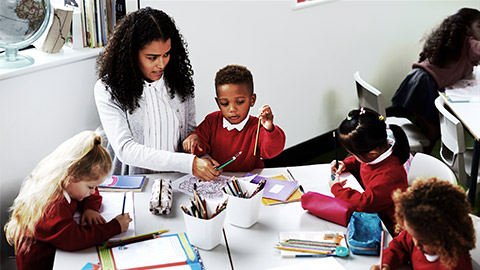
When the National Quality Framework was introduced, the educator to child ratios were also determined and communicated to services. Educator to child ratios means the number of children each adult in the learning space can be responsible for. There are a number of factors that services need to consider as part of the ‘ratios’ in a room. These considerations include:
- Service type
- Staff qualifications including access to an early childhood teacher (ECT)
- Number of children in the service
- Number of educators to ensure 50 percent are qualified
- Age range of children
- The state or territory in which the services operates
- If there are children in the same group of different ages
Some states and territories have different educator to child ratio requirements. Ratios are documented and represented like this:
Where you see the number 1:4 it represents 1 educator to 4 children.
Centre-based ratio requirements4:
Ratios are calculated across the whole service (not by individual rooms). This gives providers the flexibility to respond to ensure educators are allocated appropriately based on the age and needs of children in the service. In a mixed age group of children, maintaining the ratio for each age range of children does not mean the educator to child ratio for the youngest age range must be applied to all children in an older age range. An educator who is caring for one age range of children can also be counted against another age range of children, as long as the ratio for each age range is maintained and adequate supervision is maintained at all times. Educators must be working directly with children to be counted in the educator to child ratios.
Visit the NSW Legislation website to review Regulation 125 Educator to child ratios- centre based service
Family day care ratio requirements
- 1:7 educator to child ratio
- Maximum of four children preschool age or under.
- Ratio includes the educator’s own children younger than 13 years of age if there is no other adult to care for them.
Visit the NSW Legislation website to review Regulation 123A Family day care co ordinator to educator ratios- family day care service.
Visit the NSW Legislation website to review Regulation 124 Number of children who can be educated and care for- family day care educator.
Note: 50 percent of educators working in a centre-based service must hold a Diploma level qualification.
Read the article by ACECQA titled “Qualifications for centre-based services with children preschool age or under” for more information on qualifications in ECEC.
Note
Under the National Regulations services must keep clear records of service operation, including:
- Incident, injury, trauma and illness (Regulation 87)
- Medications kept and/or administered to children at the service (Regulation 92)
- Staff records, including qualifications, information about nominated supervisors, educational leader, information about volunteers and visitors, educators working directly with children (Regulations 145-152)
- Children’s attendance record and enrolment information (Regulations 158-161)
- Health information kept either in children’s enrolment record or on staff file (if it’s staff-related) (Regulations 162)
- Record of service compliance (Regulation 167)
Records containing personal information must be kept locked, in a secure location, maintaining privacy and confidentiality.
Visit the NSW Legislation website to review Regulation 126- Centre based services- general educator qualification.
Visit the NSW Legislation website to review Regulation 127- Family day care educator qualification
Read Chapter 4 (Operational Requirements) of the guide to the NQF by ACECQA for more information on mixed age ratios.
Please Note - Early Childhood Services are required to comply with Australia's privacy law, knows as the Privacy Act 1988. There are some resources for our reference :
New Requirements To Australia's Privacy Law For All Early Childhood Services
Case Study
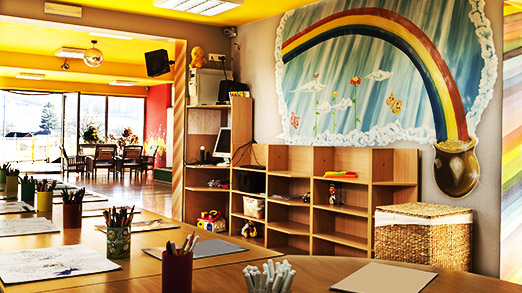
Little.ly is a service in Victoria.
On Monday, there are 10 babies under two years in the Willow Oak room, 10 children in the Bur Oak room (2-3 year old room) and 27 in the Valley Oak Kinder room (4-5 year old children).
The Director needs to work out how many staff to roster on for the day. She will need to arrange three staff for the Willow Oak room, three staff in the Bur Oak room and three staff in the Valley Oak room.
She has nine staff across the rooms for the day, and will need two people to cover lunch breaks and programming time. That means that of the 11 staff at least 50 percent need to be Diploma level qualified, or actively working towards this qualification. So, she will arrange for six staff who are qualified to be working on the day. She requires at least one Early Childhood Teacher who is rostered in the Valley Oak room.
The assessment process is the process where the state or territory Regulatory Authority assesses a service against the National Quality Standards and provides a rating to the service. After this process, the service must then display this rating in their service. The process includes a number of steps:
| Self-assessment and quality improvement |
Approved provider conducts a self-assessment to determine the quality of current practices against the NQS and linked regulatory requirements. Approved provider identifies strengths and where improvements can be made which is documented in a Quality Improvement Plan (QIP) |
|---|---|
| Notice of visit | Regulatory authority provides written notice approved provider that the assessment and rating process has commented. The QIP is submitted to the regulatory authority prior to the visit, along with any additional information requested by the regulatory authority. |
| Assessment and rating visit takes place at the service | |
| Draft report | Regulatory authority provides the approved provider with draft assessment and rating report |
| Feedback on draft report | Provider can giver feedback on any factual inaccuracies in the report and evidence to support feedback |
| Final report and notice of final ratings is issued to provider | Feedback considered before final report is finalised and issued. |
| Final report | Approved provider may choose to apply for a review of final ratings within the set review period. |
| Ratings published on national registers | Once the review period has ended, the final ratings are published on the national registers on the ACECQA website. |
Quality improvement and self-assessment
All services must have their own Quality Improvement Plan and go through an ongoing process of self-assessing their service against the National Quality Standards. This can include a range of activities such as critical reflection, discussions, staff meetings and gathering feedback from families and children. Services record their thinking in their Quality Improvement Plan, develop goals to achieve and record their progress and any exceeding themes.
Download the Optional Quality Improvement Plan template by ACECQA.
Download the Optional Self-Assessment Template by ACECQA.
Assessment visit by Authorised Officer

A service will be notified that they are going through the assessment process and will be asked to send their QIP to the Authorised Officer by a specified date. Following the receipt of this, an Authorised Officer contacts the service to discuss the service visit and will inform them of the date[s] of the visit and who will be attending.
The service can prepare for the visit by engaging in critical reflection and improving practices, however the day is designed to be an example of how the service operates on a day-to-day basis.
Watch this 19-minute YouTube video by ECA learning Hub titled “The quality improvement process” to learn more about the quality iImprovement planning and assessment process:
Access the template and read the information sheet by ACECQA providing more information on the various components of the Assessment and Rating report.
Observe
Observing practice gives you a true picture of what is happening in practice – while all methods of evidence collection are important, observing practice allows authorized officers to view your service, it’s practice and understand how the service is operating.
Example
- Interactions between children and educators
- Interactions between educators and families
- Interactions between children
- Children engagement levels
- The learning environment
- The curriculum being implemented
- Opportunities for learning
- Routine and care practices
- Health and safety practices
Discuss
Discuss is another form of evidence collection. This is where authorised officers will ask strategic questions to allow you to respond to what has occurred/ happening.
Example
- How educators respond in an emergency
- Educator duty of care responsibilities
- Child protection responsibilities
- Relationships and partnerships with families
- How educators and the service work with the community
- Practices they have not seen before
- Critical reflection and how this informs practice
Sight
The last form of evidence collection is sight. Sight is used as a way to check and confirm practices are occurring.
Example
- Health and safety checklist
- Educational program documents
- Operational paperwork
- Enrolment forms
- Staff qualifications
- Risk assessments
- Critical reflections
Case Study
-sml.jpg)
On the visit date, the Authorised Officers visiting the service seek to determine a service rating based on what they observe, discuss and sight. Following is a list of things an Authorised Officer might be reviewing in a service during a visit. They may ask staff or management questions, observe in the rooms, and review documentation or evidence of the service meeting or exceeding the National Quality Standards.
National Quality Standard Ratings
In addition to QA, all services MUST meet the regulations that protect the welfare of children. The overall NQS Rating for a service is calculated from its results in the seven quality areas.
Seven quality areas
| Quality Area 1 | Educational program and practice |
|---|---|
| Quality Area 2 | Children's health and safety |
| Quality Area 3 | Physical environment |
| Quality Area 4 | Staffing arrangements |
| Quality Area 5 | Relationships with children |
| Quality Area 6 | Collaborative partnerships with families and communities |
| Quality Area 7 | Governance and leadership |
Quality Rating
Most services receive one of these three (3) ratings.
- Working Toward
- Meeting
- Exceeding
Services not yet assessed
Services not yet assessed are given a rating of ‘Provisional—Not yet assessed under the National Quality Framework’ and must display this rating at the service.
Significant Improvement Required
The NQS rating given when a service fails to meet requirements in a way that poses unacceptable risk to the safety, health and wellbeing of the children. The regulatory authority will take immediate action and may monitor the service’s operation closely for a period of time.
Working Towards
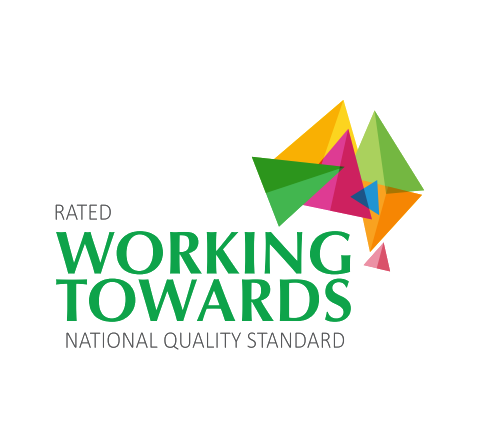
The NQS rating given if one or more QAs are rated at this level What does it mean?
- a mix of quality areas were rated:
- at the Meeting and Exceeding level AND
- at least one QA at Working Towards level OR
- All seven QAs rated at Working Toward
Meeting

The NQS rating given if all quality areas are rated at this level, or higher
What does it mean?
- a mix of quality areas rated:
- at Meeting and Exceeding, OR
- all seven quality areas rated Meeting
Exceeding

The NQS rating given if four or more quality areas are rated Exceeding, including two of the key quality areas - QA1, QA5, QA6, QA7
What does it mean?
four or more QA's rated at Exceeding (must include two of the key areas listed above) OR all seven QA's rated at Exceeding
Excellent
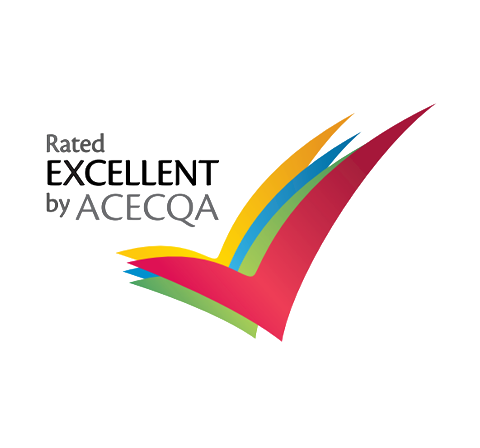
The highest possible NQS rating given.
This rating can only be awarded by ACECQA.
Providers that have rated Exceeding NQS can choose to apply for this rating.
You can find a list of Excellent rated services on ACECQA’s website, using the interactive map. If you click on the individual service, you can find out more information about their practices and the reasons why they have been awarded by the Excellent rating.
Exceeding themes
In order to achieve Exceeding the NQS rating, services must have demonstrated how they meet the exceeding themes of:
Themes:
- Embedded in service operations
- Informed by critical reflection
- Shaped by meaningful engagement with families and/or the community
Starting Blocks
You can use the ‘Find child care’ search function from StartingBlocks.gov.au to search for services across Australia. Apart from the services’ address and contact details, you can also see their rating within the seven quality areas. The search function also allows you to filter your search by service type, vacancy, service rating or age group.

Learning Frameworks
In Australia, under the National Quality Framework, there are Learning Frameworks that support educators to provide the best education to children through an educational program. The Learning Frameworks align closely with the National Quality Standard, and services must use the Learning Frameworks in order to meet the National Quality Standard. The current approved Learning Frameworks include:

- Belonging, Being and Becoming: The Early Years Learning Framework for Australia (EYLF) – Approved learning framework under the NQF for young children from birth to five years of age
- My Time, Our Place: Framework for School Age Care in Australia - Approved learning framework under the NQF for school age children
- Victorian Early Years Learning and Development Framework (for services in Victoria only)
Educators can design their own programming templates, approaches and styles as long as they use the Frameworks to guide their practice and documentation.
The Early Years Learning Framework (EYLF)
The Early Years Learning Framework includes guidance to educational practice, children’s wellbeing, educational Principles and learning outcomes for children.
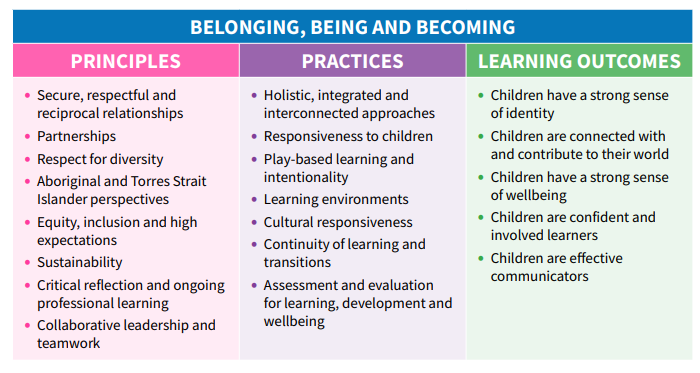
Principles
- Secure, respectful and reciprocal relationships
- Partnerships
- Respect for Diversity
- Aboriginal and Torres Strait Islander perspectives
- Equity, inclusion and high expectations
- Sustainability
- Critical reflection and ongoing professional learning
- Collaborative leadership and teamwork
Practice
- Holistic, integrated and interconnected approaches
- Responsiveness to hildren
- Play-based learning and intentionality
- Learning environments
- Cultural responsiveness
- Continuity of learning and transitions
- Assessment and evaluation for learning, development and wellbeing
The EYLF has five Learning Outcomes for educators to support children to develop. These are:
- Outcome 1: Children have a strong sense of identity
- Outcome 2: Children are connected with and contribute to their world
- Outcome 3: Children have a strong sense of wellbeing
- Outcome 4: Children are confident and involved learners
- Outcome 5: Children are effective communicators
MTOP- My Time Our Place
Under the National Law and Regulations, services are required to base their educational program on an approved learning framework. This should focus on addressing the developmental needs, interests and experiences of each child, while taking into account individual differences.
The Framework was designed for use by school age care educators working in partnership with children, their families and the community, including schools. It represents Australia’s first national framework for school age care to be used by school age care educators, and aims to extend and enrich children’s wellbeing and development in school age care settings
This Framework is linked to the Early Years Learning Framework which focuses on children from birth to five years. It extends the principles, practices and outcomes to the contexts and age range of the children and young people who attend school age care settings.
Further, the National Quality Standard for Early Childhood Education and Care and School Age Care 3 supports the implementation of this national framework by ensuring that necessary environments, facilities, staffing arrangements, resources and management structures are in place.
The difference between the two frameworks is the Intentionality and the Evaluation for wellbeing and learning in the practices sections
Victorian Early Years Learning and Development Framework
The Victorian Early Years Learning and Development Framework (VEYLDF) adopts a comprehensive approach to children’s learning and development. The VEYLDF recognises health as a crucial enabler for learning and development from birth. The VEYLDF recognises children’s wellbeing from birth as both a prerequisite for and an outcome of learning. Supportive relationships and active skill building with adults in their family and community are central to children’s wellbeing. The VEYLDF upholds the image of the child as a rights holder and a competent learner with capacities to learn from birth. The VEYLDF sets out outcomes and practices to guide early childhood professionals1 in their work with all families and their young children from birth. Supporting children to progress toward these outcomes, in conjunction with their families, is the core of the VEYLDF.
Reflective Practice or Critical Reflection
As part of their engagement with and implementing the Learning Framework, educators must engage in critical reflection through reflective practices. Educators are guided to question their practices, approaches and learning opportunities for children to continue to develop as professionals. Reflection is key to the effective implementation of a quality curriculum and supports educational teams to learn together.
Reflective practices can include discussions during staff meetings, written reflections, program reflections and dialogue as part of the self-assessment process. There are so many opportunities on a daily basis for educators to reflect together and consider new perspectives, ideas and solutions to problems.
Access and download the the Educators’ Guide provided by ACECQA to learn more about the implementation of the approved Learning Frameworks:
- Educators' Guide to the Early Years Learning Framework for Australia
- Educators' Guide to the Framework for School Age Care in Australia
Case study

On Monday, there are 10 babies under two years in the Willow Oak room, 10 children in the In the toddler room, the educators have noticed that a group of children have been experiencing conflict over toys in the mornings around 10:00 a.m. This has been causing some concerns for the educators who have found that they are more focused on managing the conflict than engaging in learning with children.
The team decided to write up a question on their board for the following week to guide their critical reflection process. The question they decided to ask was: What is happening leading up to the time when the conflict arises and what changes can we make that will reduce conflict and engage children in learning?
During the week, they began observing and noted on their critical reflection sheet that it was happening around 10:00 a.m. right before they begin packing away to head outside. Until now they have not been outside and their routine includes outdoor play from 10:30 a.m.
They also noted that all children had arrived prior to 8:30 a.m. and they have all been together since that time.
On Tuesday, they tried something different, they tried heading outside earlier. This did make a difference and the conflict did not arise.
The next day, however, they spent the whole morning outside, and children were beginning to show cues that they were tired and did not want to be outside by 10:00 a.m.
The team leader did some research and shared on their Teams App the article that talks about indoor and outdoor play.
They discussed this at length and one educator said she had done that at a previous service, and it has worked really well. She shared her knowledge about how it works.
They tried the approach of having indoor and outdoor play with the doors open and children having a sense of agency to choose where they played. This was a success and they decided to continue this practice
Watch this 3-minute video by U of G Library titled “What is a Critical Reflection Introducing the “What, So What, Now What” Model.”
Use the following questions to check your knowledge. You can check the correct answer by clicking on the 'Answer' button:

Q1: Explain what the service ratings are under the National Quality Standard.
Q2: List the NQS Quality Areas.
- Quality Area 1: Educational Program and Practice
- Quality Area 2: Children's health and safety
- Quality Area 3: Physical Environment
- Quality Area 4: Staffing Arrangement
- Quality Area 5: Relationship with Children
- Quality Area 6: Collaborative Partnerships with Families and Communities
- Quality Area 7: Governance and Leadership
Q3: Explain what the Exceeding Themes are.
- Exceeding Theme 1- Practice is embedded in service operations
- Exceeding Theme 2- Practice is informed by critical reflection
- Exceeding Theme 3- Practice is shaped by meaningful engagement with families and/or the community.
Q4: Discuss what the Learning Frameworks are and how they connect to the NQF.
- Belonging, Being and Becoming: The Early Years Learning Framework for Australia (EYLF) – Approved learning framework under the NQF for young children from birth to five years of age
- My Time, Our Place: Framework for School Age Care in Australia - Approved learning framework under the NQF for school age children Victorian Early Years Learning and Development Framework (for services in Victoria only)
Q5: Describe critical reflection.
- discussions during staff meetings
- written reflections
- program reflections and dialogue as part of the self-assessment process.
There are so many opportunities on a daily basis for educators to reflect together and consider new perspectives, ideas and solutions to problems.

